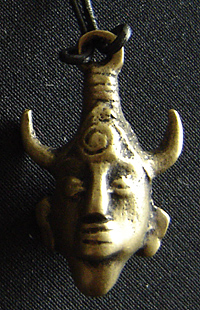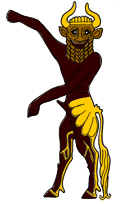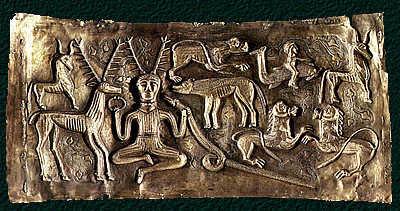Difference between revisions of "Dean's Amulet"
(→Speculation on the meaning of the amulet) |
|||
| Line 17: | Line 17: | ||
The fandom nickname for the amulet is the [[Samulet]]. | The fandom nickname for the amulet is the [[Samulet]]. | ||
| + | |||
| + | See also: [[Dean's Ring]] | ||
== Speculation on the meaning of the amulet== | == Speculation on the meaning of the amulet== | ||
Revision as of 14:16, 28 August 2010

Contents
The history of the amulet
In a flashback during 3.08 A Very Supernatural Christmas, we find out that eight year old Sam obtained the amulet from Uncle Bobby, who said it was 'real special'. Sam intends it as a Christmas present for John, but when John doesn't make it home for Christmas, and after finding out that John has lied to him about his mother's death and hunting, Sam decides to give Dean the amulet.
- Sam (holding out the wrapped gift to Dean): Here. Take this.
- Dean: No. No, it's for Dad.
- Sam: Dad lied to me. I want you to have it.
- Dean: You sure?
- Sam: I'm sure.
- Dean (opening the wrapping to reveal Dean's Amulet): Thank you Sammy, I ... I love it.
Dean wears the amulet from this time on. When he returns from Hell, Sam is wearing it, and gives it back to Dean. 4.01 Lazarus Rising. Later Castiel reveals that the amulet is very powerful and will burn hot in God's presence, and that he wishes to use it in his search for God. Dean very reluctantly hands it over, remarking that without it he "feels naked".
After their time in Heaven when Joshua reveals God is disinterested in further helping stop the Apocalypse and that the amulet will not help them find Him, Castiel returns the amulet to Dean saying "it's worthless." 5.16 Dark Side Of The Moon. As Sam is trying to reassure dean that they can still stop the Apocalypse, Dean leaves the motel room, dropping the amulet into a wastebasket on the way out.
The fandom nickname for the amulet is the Samulet.
See also: Dean's Ring
Speculation on the meaning of the amulet
Since the beginning of the show there has been much speculation about the amulets significance in terms of mythology or magic.
Fans were asking Kripke, and Jensen, about the amulet's significance from the beginning of the series. At the William S. Paley Television Festival panel in March 2006, Kripke hinted that the amulet was more than just a piece of jewellery:
Audience member: Dean always wears a certain necklace. Does it mean anything?
John Shiban: It’s from Sacramento.
Jensen: You’re gonna hang me out to dry on this one?
Eric: Oh yeah.
Jared: Mwahaha.
Jensen: It does has significance but we can’t talk about it.
In a behind-the-scenes Supernatural special, Jensen Ackles (Dean) calls the amulet his character is wearing an "Egyptian safety symbol".
After the revelation in 3.08 A Very Supernatural Christmas, that the amulet was a gift to Dean from Sam, the most obvious meaning of the amulet is as a symbol of the bond between Sam and Dean. For this reason some fans refer to it as the Samulet
Fans have continued to press for more information. In an interview with Eclipse magazine:
Q: In the Christmas episode, it was shown that the amulet that Dean wears originally came from Bobby. Why hasn’t anyone asked Bobby all these years what that amulet is all about?
Eric: In my mind, I think they know what it is and what it can do but we haven’t revealed that to the audience yet. There is a little extra mojo to it but we’re saving that card for just the right moment. I think the boys know, but it just hasn’t come up in their direct cases yet.
In 5.02 Good God Y'All, Castiel reveals that the amulet is very powerful and that it "burns hot in God's presence".
After their time in Heaven when Joshua reveals God is disinterested in further helping stop the Apocalypse and that the amulet will not help them find Him. 5.16 Dark Side Of The Moon
Where's the amulet?
- It is not visible on the Season 1 DVD, Season 2 DVD, Season 3 DVD, or Season 4 DVD Covers.
- In 2.01 In My Time Of Dying (episode) Dean does not have the amulet on while in hospital
- In 2.19 Folsom Prison Blues (episode) Dean is not wearing the amulet (or his ring) before his arrest, obviously anticipating his personal belongings will be confiscated in prison
- In the alternate reality in 2.20 What Is and What Should Never Be (episode), Dean wears a gold chain with a small pendant rather than his amulet. (The necklace appears to be a saint medallion.)
- In the four months between 3.16 No Rest For The Wicked and 4.01 Lazarus Rising, Sam kept the amulet. He is wearing it, when he takes it off and returns it to Dean in 4.01 Lazarus Rising.
- We see Dean take the amulet off when he makes love to Anna in the Impala in 4.10 Heaven And Hell - probably because getting hit in the head by a lump of brass would spoil the mood.
- Young Dean wears the amulet in 4.13 After School Special
- Dean gives the amulet to Castiel in 5.02 Good God Y'All to help him find God. Castiel says it is "Very rare, very powerful. It burns hot in God's presence. it'll help me find him.".
- In 5.04 The End, Future!Dean was not wearing his amulet.
- As of 5.16 Dark Side Of The Moon, Castiel returns the amulet to Dean and in turn, Dean drops the necklace into a wastebasket.
Speculation on Mythological roots of the amulet
- The amulet depicts a humanoid head with bull-like horns (pointing upwards), rather than ram-like horns (pointing down).
- The stylistic elements don't appear to be typically Egyptian.
Bull gods or gods with horns exist in a variety of cultures and religions. Some examples include:
Apis Bull (Egyptian)
The Egyptian Apis Bull, which is most commonly depicted with a white triangle on its forehead. Egyptian gods are usually depicted with a human body and animal heads, while Dean's "Egyptian symbol" shows a human face with a bull's attributes.
Bull-man (Mesopotamian)
According to Mesopotamian mythology, the Bull-man is a demon. He is a man above the waist and a bull below the waist. He also has the horns and the ears of a bull.
The Bull-man helps people fight evil and chaos. He holds the gates of dawn open for the sun god Shamash and supports the sun disc. He is often shown on cylinder seals. (source)
Further info:
- Mesopotamian Gods, Goddesses, Demons and Monsters
- Mesopotamian Mythology at Wikipedia
- Bull-man at Wikipedia
Hathor (Egyptian)
Hathor, a female cow deity of the Egyptians (both male and female cattle of some species have naturally-occurring horns). She is sometimes depicted as having the head of a cow; but as the goddess became more associated with cows, depiction of Hathor grew to include a human face with cow's ears and horns. Against Egyptian artistic norms (Gods and people were typically depicted in profile), Hathor began more often to be portrayed in a portrait style so that the whole of the face could be seen. In addition to her role as a fertility and women's goddess, she also represents love, joy, music and drink. She was also known for protecting young female entertainers. Hathor appears to share many similarities with the Egyptian goddess Bat, and may be a later or concurrent incarnation of that deity. There is some disagreement within Supernatural fandom as to the likelihood of the amulet being one sacred to Hathor, or that Dean would wear such an amulet. Some believe that the face on the amulet appears stylistically more male than female.
Further info:
Mithras (Zoroastrian)
Mithras (Mitra or Mitras) was a Zoroastrian god. He is often shown slaying a sacred bull.
Mithra is not present in the Gathas of Zarathustra (Zoroaster) but appears in the younger Yashts of the Avesta (Campbell p 257). There, Mithra comes to the fore among the created beings. "I created him" Ahura Mazda declares to Zoroaster, "to be as worthy of sacrifice and as worthy of prayer as myself" (Campbell, loc. cit.). In the Yashts, Mithra gains the title of "Judge of Souls" and is assigned the domain of human welfare (which he shares with the Creator). Mithra occupies an intermediate position in the Zoroastrian hierarchy as the greatest of the yazatas, the beings created by Ahura Mazda (Ormuzd in later Persian) to aid in the destruction of evil and the administration of the world. He is then the divine representative of the Creator on earth, and is directed to protect the righteous from the demonic forces of Angra Mainyu (Ahriman in later Persian). (WIKI)
Interestingly, as the amulet was a Christmas present, December 25th was originally the date of the celebration of Mithras' birth rather than that of Jesus, but the celebration was co-opted by the Christian Church.
In the Roman Empire the Mithras-Cult was a cult very popular among soldiers.
Other Horned Gods
Other representations of "horned gods" appear within various ancient religions. Such figures include the Celtic Cernunnos, and the Greek god Pan. Another possible inclusion is the Minoan Minotaur.
The image of a horned man or god appears to have held ceremonial or religious significance as early as the Old Stone Age as depicted in a Paleolithic cave painting known as "The Sorcerer".
Specifically, the image of the pendant could be seen to appear similar to a well known representation commonly accepted to be Cernunnos on the Gundestrup Cauldron. Though the original was made from silver, recreations of the image are commonly cast in bronze. A very similar depiction, found on a seal in the Indus Valley connected to of Hindu figure Pashupati, seems to bear the horns of a bull as the amulet does.
These representations bear sometimes similar associations with animals, nature, fertility, the primordial wild. Occasionally, the association is also extended to hunting.
Further info:
Possible connection to Joseph Campbell's Hero's Journey
This plate appears in Joseph Campbell's The Hero with a Thousand Faces, which documents his Hero's Journey. This theory has been acknowledged by Eric Kripke and other creators of Supernatural as being highly influential to the narrative arc of the show.
The note for the plate reads: The Monster Tamer (Sumer) Shell inlay (perhaps ornamenting a harp) from royal tomb at Ur, ca. 3200 B.C. The central figure is probably Gilgamesh. (Courtesy of The University Museum, Philadelphia).
It is the first plate in the 1993 edition printed by Fontana Press in Great Britain. It appears after p.168.
The concepts of heroism and the heroic figure, such as this image, can be found in Sumerian culture in forms not seen in earlier incarnations. This is due to the ways the concept of 'good versus evil' was changing. This change resulted, as detailed in the excerpt below, with the rise of Zoroastrian dualism as a method of thought.
Persian mythology is rooted in the common Indo-European system that was carried out of the Aral-Caspian steppes into India and Iran, as well as into Europe. The principal divinities of the ealiest sacred writings of the Persians correspond very closely to those of the earliest Indian texts. But the two branches came under greatly differing influences in their new homes, the Vedic tradition submitting gradually to Dravidian Indian forces, the Persian to Sumero-Babylonian.
Early in the first millennium BC, Persian belief was reorganised by the prophet Zarathrustra (Zoroaster) according to a strict dualism of good and evil principles, light and dark, angels and devils. This crisis profoundly affected not only the Persian, but also the subject Hebrew beliefs and thereby (centuries later) Christianity. It represents a radical departure from the more usual mythological interpretation of good and evil effects proceeding from a unique source of being that transcends and reconciles all polarity. (ibid, p.348n)
- dramaqueen469 argues that Dean's Amulet is an important symbol when it comes to the distribution of roles in the Apocalypse.



